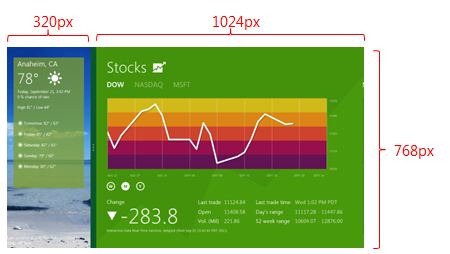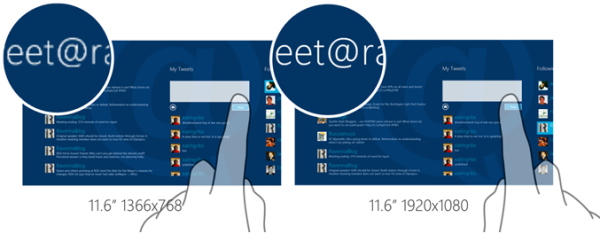Microsoft Talks Screen Resolution in Windows 8, Suggests "Retina"-esque Tablets
by Andrew Cunningham on March 22, 2012 10:30 AM ESTMicrosoft's David Washington has penned another informational tome on the Building Windows 8 blog, this one about Windows 8 and its support for varying screen resolutions. The above chart lists the common (but not the only) resolutions that Microsoft is planning for, and while most of the listed display types won't surprise anyone (wall-to-wall 1366x768 and 1920x1080 for most desktops and laptops), it does appear as though Microsoft is planning for Windows tablets with a DPI that approaches or matches that of the new iPad.
Microsoft is planning for tablets that use both the 1024x768 and 1366x768 resolutions common in earlier and lower-end tablets as well as the high-DPI screens that are being (and will be) ushered in by the new iPad. To scale Windows elements so that they're still comfortable to look at and touch at these resolutions, Microsoft has put together some pre-defined scaling percentages: 100% when no scaling is applied, 140% for 1080p tablets, and 180% for quad-XGA tablets like the new iPad. These percentages were all chosen as "pixel density sweet spots" for 10" and 11" tablets with 1920x1080 or 2560x1440 displays. It should be noted that Washington's blog post focused entirely on Metro scaling - whether the Windows desktop will automatically scale using these percentages is unclear.
Microsoft's attention to these specific resolutions suggests that we will probably see some high-DPI Windows tablets when they launch in the fall, though we still don't know anything about the tablets OEMs are designing for Windows 8 and Windows on ARM. It's also telling that there are no 7" tablets on that chart - we may not see Windows versions of smaller tablets like the Kindle Fire or Nook Tablet.
Washington went on to explain the reasoning behind the minimum resolution requirements for Metro apps that we noticed in our Windows 8 preview review - 1024x768 for Metro apps and 1366x768 for the Metro Snap feature. Both choices were largely developer and data-driven: 1024x768 is a common low-end resolution for web developers and tablet app developers, and Microsoft didn't want to restrict these developers to a lower minimum resolution to account for the small percentage of 800x600 and 1024x600 displays that are currently in use.

As for snapped apps: the size for a "snapped" app is always 320 pixels wide, which was again selected because developers have become used to it in their work with smartphones. A 1366x768 display is the lowest common screen resolution that allows for the 320 pixel width and the 1024 pixel minimum width for regular Metro apps.
Also discussed was the methods by which Metro allows programs to expand to take up all of the pixels in a larger laptop or desktop display: To help dynamically expand content to take up more screen space when the pixels are available, Windows 8 uses the same XAML and CSS3 features that are commonly used to accomplish this on modern web pages - examples of such features include the grid, flexible box, and multi-column CSS3 layouts. App templates provided with Visual Studio 11 all make use of these features automatically. Developers can also scale their apps to fit larger displays, which is useful for games or other apps that don't need to make use of additional pixels.
For more, including Windows 8's support for scalable graphics and the Windows Simulator tool that will provide Visual Studio 11 users the ability to test their apps at multiple screen resolutions, the full post is linked below for your convenience.
Source: Building Windows 8 blog











29 Comments
View All Comments
bigboxes - Thursday, March 22, 2012 - link
Agreed. I up the pointer speed on all my client's boxes. I also select the box to "Automatically move pointer to the default button in a dialog box". It takes them awhile to get used to it, but they can always back it down if it's too sensitive for them. The less you move the mouse the less fatigue you have. It's all about ergonomics.Ethaniel - Thursday, March 22, 2012 - link
I'm using a 17" LCD with 1280x720 as native resolution. And no, Metro apps won't start, including IE10. I hope Windows 8 comes with a free monitor, because I'm not going to replace mine. 48 pixels and I'm a pariah...seapeople - Saturday, March 24, 2012 - link
Not sure if you're joking, but you realize that a new and better monitor would cost less than Windows 8, right?tipoo - Saturday, March 24, 2012 - link
If it makes you feel better, I get Windows 8 for free and my hardware is all compatible, but I'm still not sure I'll be upgrading, I've used it since the first dev release and I still find it slows down multitasking tremendously.robinthakur - Monday, April 2, 2012 - link
Agreed, I'm not upgrading based on my experience with the Consumer Preview, and the usability issues and my place of work has just announced the same. Seriously MS, get a grip. Apple's tablet with its superb screen resolution is on the market TODAY. Your product is still on the drawing board, but won't even match the resolution? It's like they plan to fail....I forsee Windows 8 being a bit of a disaster based on what people expect from Windows (err the Windowed interface) having been substantially messed with.nofumble62 - Friday, March 23, 2012 - link
Stop giving me 1080 resolution, LCD manufacturers. It is about time, give us something better than that.piroroadkill - Friday, March 23, 2012 - link
The thing is, they never used to. It was always 1920x1200 on the high end, then the 1080p crazy started, hard.Now everyone offers 16:9, which is a worthless ratio on a smaller screen:- I don't spend all my time watching films..
Hector2 - Friday, March 23, 2012 - link
I'm waiting for Apple to say they patented the number of pixels per inch for their latest iPad. LOLMadMacMan - Sunday, March 25, 2012 - link
High-end screens have always been hugely important to me. I, too, am hoping that we will see super hi-res hi-pixel density in the upcoming Ivy Bridge refreshes from Apple, at least as an option. Almost equally as important to me is finally seeing at least SOME MacBook Pro's and/or Air's adopt IPS technology into their respective panels, something that is found in every iPad and even the iPhone since the iPhone 4 on the smaller-size end, as well as Apple's iMac's and Cinema Displays (stand-alone monitors) at 24", 27" and 30". HP just came out with a $700 2560x1440 IPS monitor with 10-bit graphics, which was a welcome sight. So what if it doesn't have HDMI ports. Just get a DisplayPort-to-HDMI adapter and all will be well, availability of quality drivers permitting. HP also brought back IPS in its highest-end EliteBooks a couple of years ago. They call it their "DreamColor" display, and if I hadn't switched to Apple after Lenovo dropped 17" ThinkPad's altogether in 2010, I'd probably own one of those EliteBook's.As far as my entertainment goes, I get it on my 27" Cinema Display (1440p; 16:9) which sits right in front of me and on my 1080p projector on a 120" screen but from a 12' distance. Both solutions are nothing short of spectacular and unless my circumstances change dramatically, I have no plans to get another HDTV, at least until 4K resolution is in the "affordable" range. My projector is so sharp that it is even comfortable to work on for brief periods of time, such as writing up this quick reply. ;-)
Windows 8 runs well in a virtual machine on my MBP, but the jury is still out as far as using it over Windows 7 is concerned.